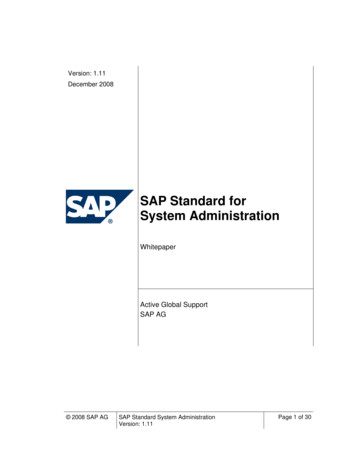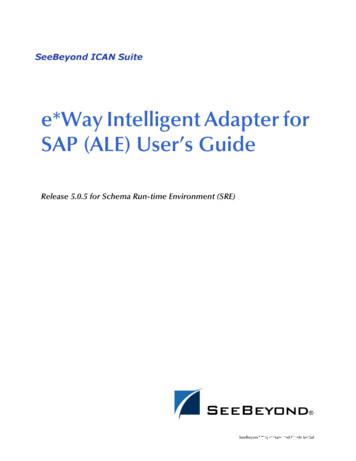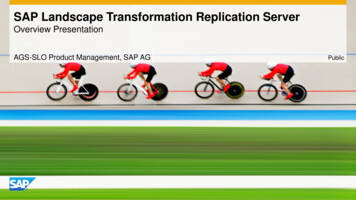SAP Standard For System Administration
Version: 1.11December 2008SAP Standard forSystem AdministrationWhitepaperActive Global SupportSAP AG 2008 SAP AGSAP Standard System AdministrationVersion: 1.11Page 1 of 30
SAP Standard for System AdministrationChange history:VersionDateChanges1.0April 2007Original version1.1August 2008 Enhancement and restructuring of chapter 4 Enhancement and restructuring of chapter 5 Enhancement of chapter 61.11December 2008 2008 SAP AG Adjustment of the description of SAP Net WeaverAdministrator (section 4.5.2)SAP Standard System AdministrationVersion: 1.11Page 2 of 30
SAP Standard for System AdministrationTable of Content1Management Summary .42SAP Standards for E2E Solution Operations.53The System Administration Standard at a Glance .84What is the Basic Concept of the System AdministrationStandard? .94.14.24.34.44.54.5.14.5.2Architecture and Process Flow.9Solution Landscape in SLD and SAP Solution Manager.10Administrative Tasks .11Organization (People).15Tools.16Work Center .17Important Administration Tools.185How to Implement the System Administration Standard? . y .23Setup .24Process Implementation Steps.24Output.25Trainings.256How to Measure the Success of the Implementation?. 286.16.2Benefits.28Setting up KPI monitoring.28 2008 SAP AGSAP Standard System AdministrationVersion: 1.11Page 3 of 30
SAP Standard for System Administration1 Management SummaryManaging complexity, risk, costs as well as skills and resources is at the heart of implementing mission critical support for SAP-centric solutions. The complexity rises even further withthe trend of outtasking and outsourcing of process components. To help customers managetheir SAP-centric solutions, SAP provides a comprehensive set of standards for solution operations.Out of this set of standards, the system administration standard describes processes for theadministration of SAP-centric solutions. The term “system administration” encompasses allactivities that are required to ensure the successful, long-term operation of a solution from atechnical perspective. The range of activities that can be included in the broadest sense ofsystem administration is therefore very extensive. As usual in this context, the main areas ofsystem administration are treated separately. The procedures in the main areas of use (suchas Data Management, Change Management, and Incident Management) are explained inseparate documents. This document provides an overview of the various, regularly occurringstandard system administration tasks and associated tools.Over the course of evolution to enterprise service-oriented architecture (enterprise SOA)solutions, vertical system administration based on a technical system gives way to horizontalsystem administration based on processes. Consequently, the different subject areas in system landscape administration must be combined and provided in a central location. The platform for this is SAP Solution Manager. 2008 SAP AGSAP Standard System AdministrationVersion: 1.11Page 4 of 30
SAP Standard for System Administration2 SAP Standards for E2E Solution OperationsMission-critical operations is a challenge. While the flexibility of SAP-centric solutions rises,customers have to manage complexity, risks, costs, as well as skills and resources efficiently.Customers have to run and incrementally improve the IT solution to ensure stable operationof the solution landscape. This includes the management of availability, performance, process and data transparency, data consistency, IT process compliance, and other tasks.Typically, multiple teams in the customer organization are involved in the fulfillment of theserequirements (see figure 1). They belong to the key organizational areas Business Unit andIT. While the names of the organizations may differ from company to company, their functionis roughly the same. They run their activities in accordance with the corporate strategy, corporate policies (for example, corporate governance, compliance and security), and the goalsof their organizations.Figure 1: Organizational model for solution operationsThe different teams specialize in the execution of certain tasks: On the business side, endusers use the implemented functionality to run their daily business. Key users provide firstlevel support for their colleagues. Business process champions define how business processes are to be executed. A program management office communicates these requirements to the IT organization, decides on the financing of development and operations, andensures that the requirements are implemented.On the technical side, the application management team is in direct contact with the business units. It is responsible for implementing the business requirements and providing sup 2008 SAP AGSAP Standard System AdministrationVersion: 1.11Page 5 of 30
SAP Standard for System Administrationport for end users. Business process operations covers the monitoring and support of thebusiness applications, their integration, and the automation of jobs. Custom developmenttakes care of adjusting the solution to customer-specific requirements and developments.SAP technical operations is responsible for the general administration of systems and detailed system diagnostics. And the IT infrastructure organization provides the underlying ITinfrastructure (network, databases ). Further specialization is possible within these organizations as well. For example, there may be individual experts for different applications withinSAP technical operations.Efficient collaboration between these teams is required to optimize the operation of SAPcentric solutions. This becomes even more important if customers engage service providersto execute some of the tasks or even complete processes. Customers have to closely integrate the providers of outtasking and outsourcing services into the operation of their solutions.Key prerequisite for efficient collaboration of the involved groups is the clear definition ofprocesses, responsibilities, service level agreements (SLAs), and key performance indicators(KPIs) to measure the fulfillment of the service levels. Based on the experiences gained bySAP Active Global Support while serving more than 36,000 customers, SAP has definedprocess standards and best practices, which help customers to set up and run End-to-End(E2E) Solution Operations for their SAP-centric solutions. This covers not only applicationsfrom SAP but also applications from ISVs, OEMs, and custom code applications integratedinto the customer solution.SAP provides the following standards for solution operations: Incident Management describes the process of incident resolution Exception Handling explains how to define a model and procedures to manage exceptions and error situations during daily business operations Data Integrity avoids data inconsistencies in end-to-end solution landscapes Change Request Management enables efficient and punctual implementation ofchanges with minimal risks Upgrade guides customers and technology partners through upgrade projects eSOA Readiness covers both technical and organizational readiness for enterpriseservice-oriented architectures (Enterprise SOA) Root Cause Analysis defines how to perform root cause analysis end-to-endacross different support levels and different technologies Change Control Management covers the deployment and the analysis of changes Solution Documentation and Solution Documentation for Custom Code definethe required documentation and reporting regarding the customer solution Remote Supportability contains five basic requirements that have to be met to optimize the supportability of customer solutions Business Process and Interface Monitoring describes the monitoring and supervision of the mission critical business processes 2008 SAP AGSAP Standard System AdministrationVersion: 1.11Page 6 of 30
SAP Standard for System Administration Data Volume Management defines how to manage data growth Job Scheduling Management explains how to manage the planning, scheduling,and monitoring of background jobs Transactional Consistency safeguards data synchronization across applications indistributed system landscapes System Administration describes how to administer SAP technology in order to runa customer solution efficiently System Monitoring covers monitoring and reporting of the technical status of IT solutions Test Management describes the test management methodology and approach forfunctional, scenario, integration and technical system tests of SAP-centric SolutionsOut of this list, this white paper describes the system administration standard. 2008 SAP AGSAP Standard System AdministrationVersion: 1.11Page 7 of 30
SAP Standard for System Administration3 The System Administration Standard at a GlanceThe topic System Administration describes how all SAP technology must be administered torun a customer solution efficiently. Administration tasks are mainly executed locally, but canbe accessed and triggered from a central administration system. This allows a unified accessto all SAP technologies. System Administration is owned and executed by SAP technicaloperations. Possible results are smoother business execution and optimized total cost ofoperations.The typical tasks of system administration include starting and stopping systems, applyingchanges to technical configuration, performing imports, and/or applying patches and SupportPackages based on the change control workflow, creating or changing users based on acompliance workflow, performing system copies and installing systems, running system diagnostics, managing jobs, and performing backups and recovery. 2008 SAP AGSAP Standard System AdministrationVersion: 1.11Page 8 of 30
SAP Standard for System Administration4 What is the Basic Concept of the System Administration Standard?4.1 Architecture and Process FlowSAP NetWeaver is the foundation of SAP xApps and SAP Business Suite solutions, and alsopowers partner solutions and custom-built applications.Its core component, the SAP NetWeaver Application Server, is the central foundation for theentire SAP software stack. It also provides a platform for other NetWeaver components (Portal, XI etc.), as well as for ABAP and Java applications.An SAP system consists of several application server instances and a database. A dialoginstance consists of the following components: The Internet Communication Manager (ICM) sets up the connection to the Internet. Itcan process both server and client Web requests. It supports the protocols HTTP,HTTPS, and SMTP. The SAP Web AS may be a Web server or a client (see SAPWeb Application Server: Web Server or Web Client) The Dispatcher distributes the requests to the work processes. If all the processesare occupied the requests are stored in the dispatcher queue. The Work Processes execute ABAP or Java programs. The SAP Gateway makes the RFC interface between the SAP instances available(within an SAP System and beyond system boundaries). The Message Server exchanges messages and balances the load in the system. In the J2EE component of the SAP NetWeaver AS, there are also components JavaDispatcher, Server Process and Software Deployment Manager.For more details, follow this link to find a description of the Architecture.System administration must be done on the ABAP and the Java stack of a NetWeaver installation, both locally and landscape-wide, using the appropriate tools provided by SAP SolutionManager, CCMS and, in the case of Java components, in NetWeaver Administrator, amongothers. The most important administration functionalities available on both stacks are listedbelow: CCMS Data and Alerts: The CCMS monitoring infrastructure provides central accessto all important monitoring information. For example, an aborted database backuptriggers an CCMS alert. The operator in charge is notified. The operator enters thecentral operations hub, opens the corresponding CCMS monitor and starts theanalysis function, which is attached to the backup alert. The analysis function guidesthe operator to the corresponding backend system, and displays the databasebackup log for further analysis. 2008 SAP AGSAP Standard System AdministrationVersion: 1.11Page 9 of 30
SAP Standard for System Administration Workload Statistics: The workload statistics provide a central overview of the overallperformance of the landscape components. Database Administration: SAP offers a database cockpit, which centrally offers keyadministrative functionality like analyzing missing database objects, backup planning,health checks. This cockpit is currently available for MAXDB and DB2. It is plannedto be expanded for other databases with the next major NetWeaver release. Central User Administration offers central user maintenance and distribution to thebackend landscape. Transport Management Service controls the distribution of coding and customizingbetween landscape components (mainly from development to quality assurance toproduction system) to safeguard productive system availability. The User Management Engine maintains users and roles for AS Java. A central log viewer provides access to all key administrative logs of the backendsystems.4.2 Solution Landscape in SLD and SAP Solution ManagerThe system landscape provides a technical description of all components within a customersolution. This is the basis for using the SAP Solution Manager. You capture and manage thesystem landscape centrally in SAP Solution Manager, and use it in your implementation andtemplate projects, in change management, customizing synchronization (customizing scout,customizing distribution), and in operational processing (solution monitoring, services, servicedesk).SAP Solution Manager has its own repository (transaction code SMSY) with landscape component information. In case of homogeneous ABAP based solution landscapes, SMSY is thecentral place to connect your systems to (how to maintain solution landscapes in SAP Solution Manager see unit System and Solution Maintenance (SMSY) at the SAP Solution Manager7.0 learning maps for technology consultants).To create an overall concept that facilitates the implementation, upgrade and maintenance ofsystem landscapes with Java components, the System Landscape Directory (SLD) of SAPNetWeaver comes into play.System Landscape Directory contains two kinds of content: the component information andthe landscape description: The landscape description provides an exact picture of installed landscape elementsincluding the connections between the systems. The content of the landscape description is created during the landscape implementation and automatically maintained through the whole software life-cycle. The component information describes the building blocks of solutions and their possible combinations and dependencies. It describes the world of installable landscapeelements. The various types of dependencies between building blocks play an important role in landscape implementation, change management and solution validation. 2008 SAP AGSAP Standard System AdministrationVersion: 1.11Page 10 of 30
SAP Standard for System AdministrationSystem Landscape Directory is an SAP NetWeaver component. It is completely implementedwith Java technology and deployed as a Java component on the Application Server Java. AsSystem Landscape Directory is already part of every AS Java system (as of SAP Web Application Server Java 6.40 or higher), no further installation is required – you only have to perform the easy and quick configuration to activate it.In case of a large environment with non-ABAP systems and components, all landscape component information is initially sent to SLD. The SMSY repository is regularly updated withinformation from the SLD. The system data retrieved from the SLD will be automatically classified and stored under the corresponding products in SMSY. After the system data import,you have to maintain information that cannot be retrieved and maintain the RFC connectionsto the corresponding satellite systems in order to access the systems for various SAP Solution Manager usage scenarios.The following data can be automatically retrieved from the SLD: For ABAP systems:-System name and number-Message server-Clients-Installed software components, releases and patch levels-Instances of the system-Servers assigned to the instances-Server data-Databases of a system-Server of a databaseFor Java systems:-Instances of a system-Servers assigned to the instances-Server roles (types)-Installed software components, releases and patch levels4.3 Administrative TasksManaging a system landscape is a complex task of significant importance for every companythat operates one or more SAP systems. The complexity increases with every additional system, component, or extension.With the monitoring infrastructure of CCMS (Computing Center Management System), SAPprovides a flexible and universally-usable basic infrastructure with which you can manageyour entire IT landscape centrally. CCMS offers an integrated suite of tools for monitoring and 2008 SAP AGSAP Standard System AdministrationVersion: 1.11Page 11 of 30
SAP Standard for System Administrationmanaging SAP components, for automating such operations as resource distribution, and formanaging SAP-supported databases.The System Administration Work Center in SAP Solution Manager provides the CCMS administration features. Besides monitoring functionality, this work center bundles all main administrative functionality, being used on a daily operational basis.For security-relevant information, such as roles and authorizations, see the SAP NetWeaverSecurity Guide. It contains an overall overview of security with SAP NetWeaver as well aslinks to the individual guides for each of the usage types, standalone engines, connectivityand interoperability technologies, database and operating system platforms, and the variousscenarios.Administrative tasks are release and usage-type specific. A good overview of all standardadministration tasks to be processed is available in the Technical Operations Manual for SAPNetWeaver, which describes SAP NetWeaver 7.0 (2004s). SAPs Online Help pagehttp://help.sap.com offers such a manual for SAP NetWeaver 04 as well.The typical administrative scope includes tasks such as starting and stopping s
3 The System Administration Standard at a Glance The topic System Administration describes how all SAP technology must be administered to run a customer solution efficiently. Administration tasks are mainly executed locally, but can be accessed and triggered from a central administration system. This allows a unified access to all SAP technologies.
SAP ERP SAP HANA SAP CRM SAP HANA SAP BW SAP HANA SAP Runs SAP Internal HANA adoption roadmap SAP HANA as side-by-side scenario SAP BW powered by SAP HANA SAP Business Suite powered by SAP HANA Simple Finance 1.0 2011 2013 2014 2015 Simple Finance 2.0 S/4 HANA SAP ERP sFin Add-On 2.0
SAP Certification Material www.SAPmaterials4u.com SAP Certification Material for SAP Aspirants at Low cost Home Home SAP Business Objects SAP BPC CPM SAP BPC 7.0 SAP EWM SAP GTS SAP Public Sector SAP Real Estate SAP FSCM SAP FI/CO SAP AC - FI/CO SAP BI 7.0 SAP CRM 5.0
SAP Master Data Governance SAP Information Steward SAP HANA smart data integration SAP Data Hub SAP Cloud Platform Big Data Services SAP HANA, platform edition SAP Vora Customer Experience IoT Workforce Engagement SAP Cloud for Customer SAP Commerce SAP Marketing SAP Asset Intelligence Network SAP Predictive Maintenance and Service SAP .
ALE/RFC Setup 88 SAP System Type 88 SAP IDoc Version 88 Program ID (SAP to e*Gate) 88 SAP Load Balancing Usage (e*Gate to SAP) 89 SAP Application Server (e*Gate to SAP) 89 SAP Router String (e*Gate to SAP) 90 SAP System Number (e*Gate to SAP) 90 SAP Gateway Ho
SAP HANA Appliance SAP HANA DB In-Memory A io BI Client non-ABAP (SAP supported DBs) SAP Business Suite SAP Business Suite SAP Business Suite SAP Business Suite SAP Business Suite SAP Business Suite SAP Business Warehouse SAP HANA DB r In-Memory Source Systems SAP LT Replication Ser
Customer Roadmap to SAP Simple Finance - Example " Adopting SAP Simple Finance is a journey - start early" Side-by-side SAP HANA Acceleration SAP HANA accelerators, BW, BPC, GRC SAP Business Suite on SAP HANA SAP ERP on SAP HANA SAP ERP in SAP HANA Enterprise Cloud SAP Accounting Powered By SAP HANA Simple Finance add-on/
SAP Business Suite SAP BW SAP Apps Partner Apps SAP HANA PLATFORM Planning and Calculation Engine Real-Time Replication Services Information Composer & Modeling Studio SAP UI HTML5 Mobile SAP BI 4 SAP ERP SAP CRM SAP SCM SAP PLM SAP SRM SAP Netweaver Predictive Analytics & Business Function Libraries In-Memory
Sep 28, 2021 · SAP LLC “SAP Labs“ MEE Russian Federation SAP SAP CIS, LLC MEE Serbia SAP SAP West Balkans d.o.o. MEE Slovakia SAP SAP Slovensko s.r.o. MEE Slovakia SAP Ariba Ariba Slovak Republic, s.r.o. MEE Slovenia SAP SAP sistemi, aplikacije in produkti za obdelavo podatkov d.o.o. MEE Switzerland Emarsys Emarsys Schweiz GmbHFile Size: 598KB























